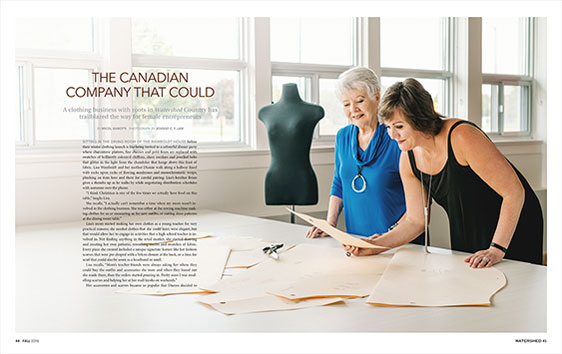
A clothing business with roots in Watershed Country has trailblazed the way for female entrepreneurs
SITTING IN THE DINING ROOM OF THE WAMBOLDT HOUSE before their winter clothing launch is like being invited to a colourful dinner party where charcuterie platters, fine cheeses and petit fours are replaced with swatches of brilliantly coloured chiffons, sheer overlays and jewelled belts that glitter in the light from the chandelier that hangs above this feast of fabric. Lisa Wamboldt and her mother Dianne walk along a hallway lined with racks upon racks of flowing sundresses and monochromatic wraps, plucking an item here and there for careful pairing. Lisa’s brother Brian gives a thumbs up as he walks by while negotiating distribution schedules with someone over the phone.
“I think Christmas is one of the few times we actually have food on this table,” laughs Lisa.
She recalls, “I actually can’t remember a time when my mom wasn’t involved in the clothing business. She was either at the sewing machine making clothes for us or measuring us for new outfits, or cutting dress patterns at the dining room table.”
Lisa’s mom started making her own clothes as a young teacher for very practical reasons; she needed clothes that she could layer, were elegant, but that would allow her to engage in activities that a high school teacher is involved in. Not finding anything in the retail market, she started drawing and creating her own patterns, reworking outfits and swatches of fabric. Every piece she created included a unique signature feature like her fashion scarves that were pre-draped with a Velcro closure at the back, or a faux fur scarf that could also be worn as a headband or muff.
Lisa recalls, “Mom’s teacher friends were always asking her where they could buy the outfits and accessories she wore and when they found out she made them, then the orders started pouring in. Pretty soon I was modelling scarves and helping her at her mall kiosks on weekends.”
Her accessories and scarves became so popular that Dianne decided to give her creations a name. Toujours Elegant was both a nod to her career as a French teacher and her belief in accessible elegance.
“It went from one kiosk to three and then it reached a point where Mom was so busy making accessories that she had to choose between teaching and her clothing business,” Lisa remembers.
“So, she swapped out our kitchen for a small warehouse, but the process of creating and matching fabric to the outfit is still inspired by the same needs that my mom had in the very beginning,” explains Lisa.
That creative process has not changed much since Dianne turned her sewing hobby into a cottage industry and now into a Canadian retail powerhouse that has supplied Costco, Tilley and T.J. Maxx as well as international retailers.
“She never really thought about the risk,” comments Lisa. “She enjoyed lots of support, from my brother and me and especially from Dad. They just made it work.”
When Lisa’s father Mike Wamboldt joined the business in the late 1990s, the family decided to move their operations out of their home and into a warehouse on Milner Avenue in Scarborough, where they still manufacture and distribute their labels Toujours Elegant, Cabana Naturals and Rapz Lifestyle Clothing.
“We are a small operation; outside the family we have two home sewers that have been with us from almost the beginning, who sew the samples from the original patterns. Then we have some full-time and part-time shipping staff, a pattern maker, and a cutter to help mom keep up with the demand to have more outfits in one design season. We will, for larger orders, also enlist additional sewers from two local companies near our warehouse,” explains Lisa.
By keeping the workforce local, Dianne maintains strict quality control and can check in on the manufacturing at any point in the process. They also source as many high-end fabrics from Canadian suppliers as they can – a move that protects them from huge tariff hikes at the border and possible delivery delays. Most importantly, Lisa and her brother Brian, manage Canadian and U.S. sales and marketing.
“Brian and I probably travel to more than 100 stores that carry our clothes a year. We have helped them with their displays, advertising and marketing and while it has been good for developing our brand, sometimes our profit margins in the early years were pretty slim, as was our time with our families,” says Lisa.
Although it was hard to sustain the hectic work schedule, Lisa credits their current success to those key decisions.
“A lot of our competitors that moved overseas have had to downsize now and some returned to Canada or had to close down altogether. I think many of them grew too fast and they traded volume for quality and they lost customers because of it,” she comments.
Speaking of keeping it local, Lisa recalls the fateful trip to Brighton that led her back to her mother’s hometown.
“I was driving through downtown Brighton and I saw the ‘for lease’ sign on what used to be the Magnolia store. Something inside me just clicked, and I knew that was the right location for the store I had always dreamed of owning! It was definitely not the right time for me. I already had a huge renovation project underway at my mom’s family home on Bullis Road, while working full-time as the Canadian sales rep for the business, but my instincts told me it was absolutely the right move,” she recounts.
Willow Lifestyle Boutique, the unassuming little store beside the Sobey’s parking lot, is one of two family- owned stores; her brother runs Kelly’s on Queen in Port Perry. Lisa credits the store as uniquely important to their Canadian operations.
“Willow is the little store that could. It keeps me connected to our client base. I see first hand what people’s buying trends are and I hear from real Canadian women what their needs are. When Mom and I sit down to plan next year’s line, we have solid market research to fuel our creativity,” she says.
Lisa adds, “I don’t think my parents realize what trailblazers they are for female entrepreneurs and for small businesses that want to remain in Canada. Whether or not our kids take on the family business, I think my parents have shown them that even though your community may be small, small communities can support big dreams.”
Story by:
Micol Marotti
Photography by:
Johnny C. Y. Lam


